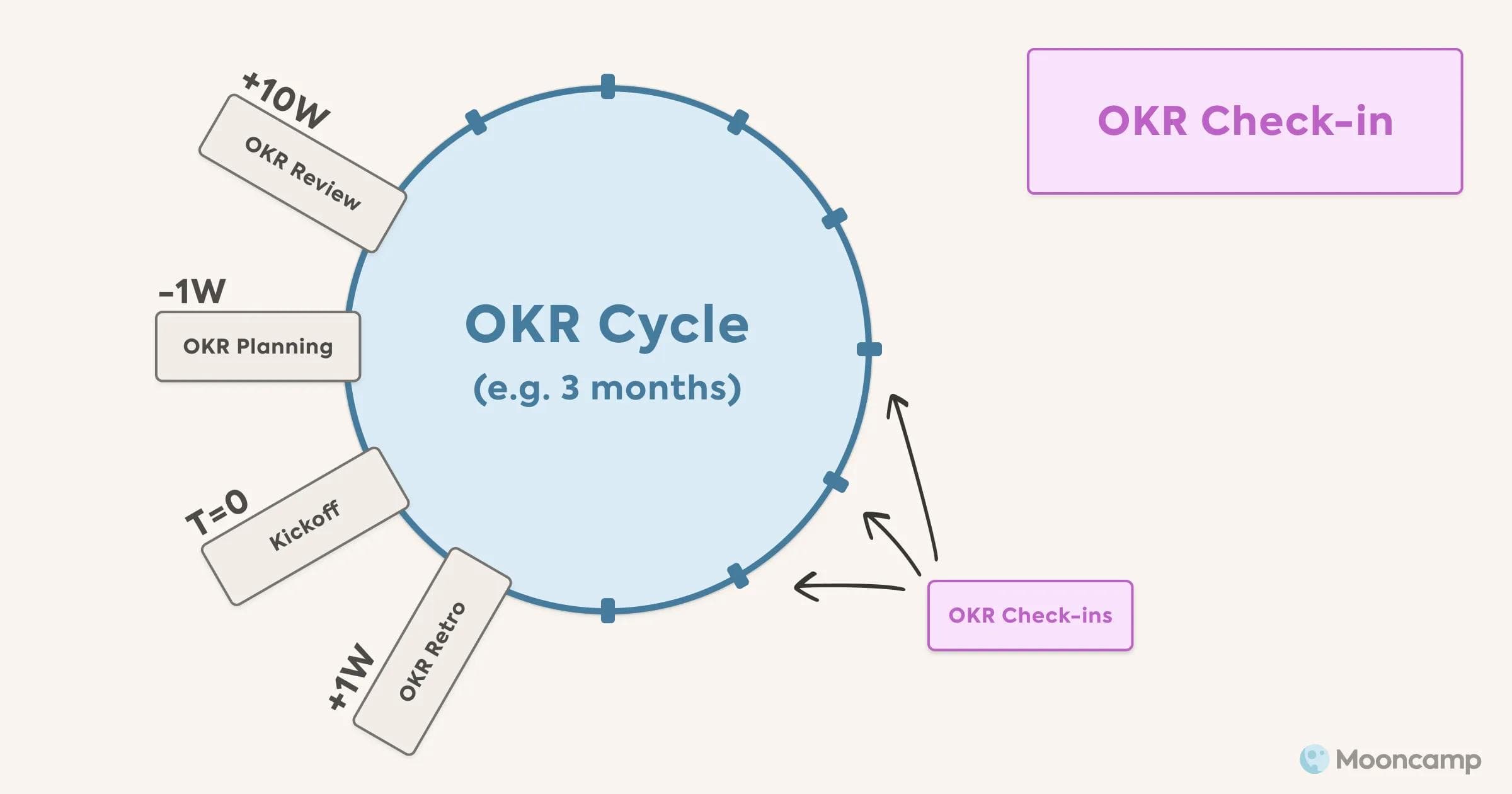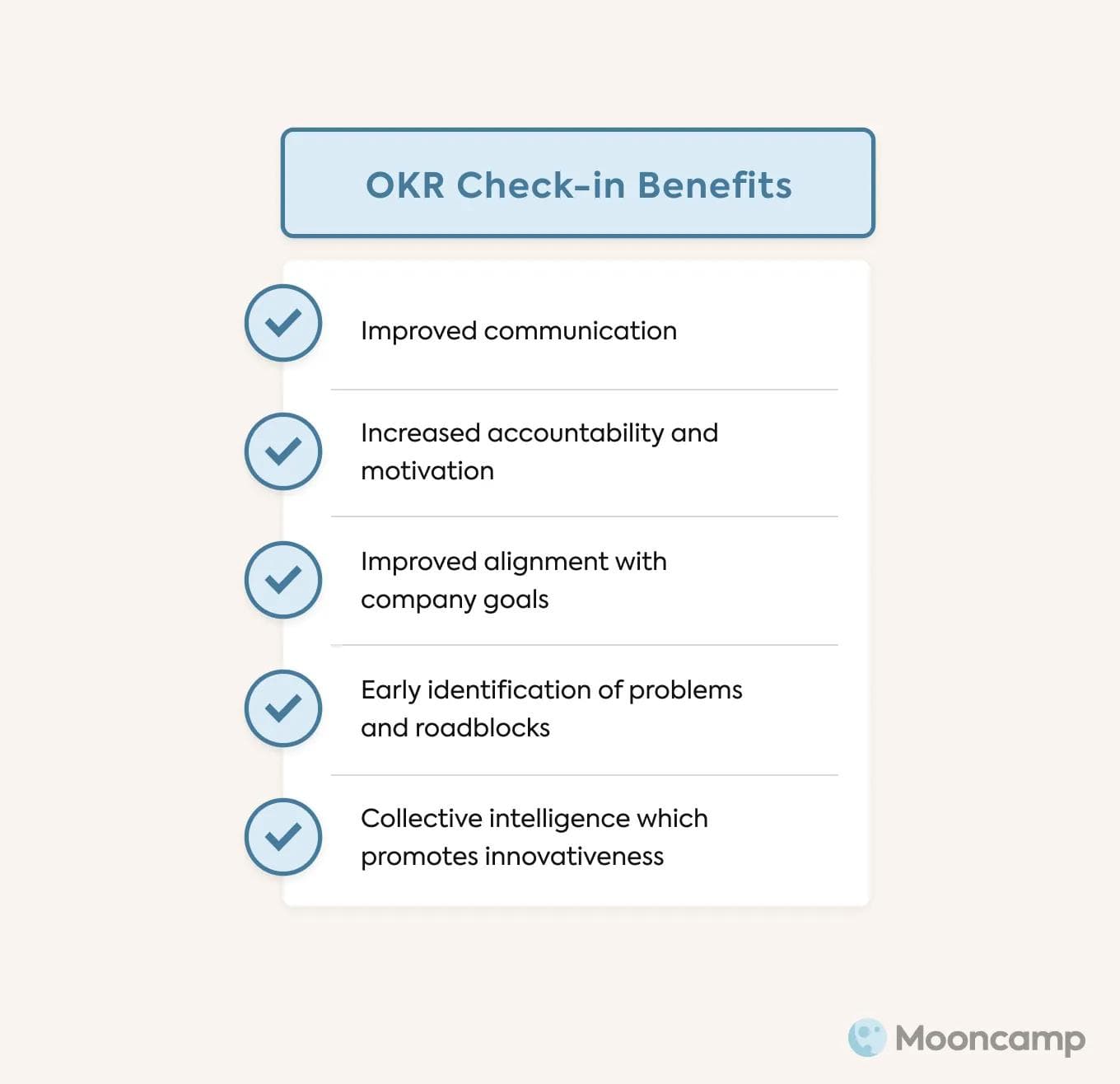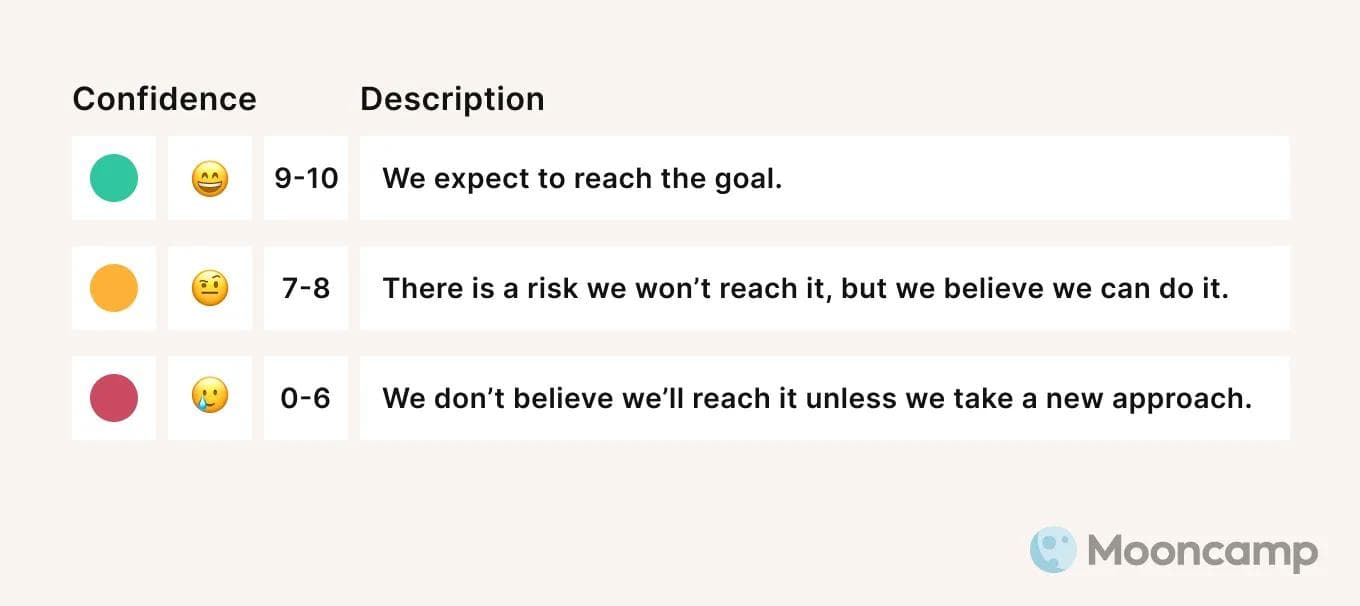OKR Check-in guide [+ template and agenda]

The (weekly) OKR check-in is probably the most important and at the same time the most underestimated event in the OKR cycle. In this article, we will outline why this is the case. We also show how to best conduct OKR check-ins – including tips, a meeting agenda and a checklist to help you prepare.
What to expect:
- What is an OKR check-in?
- Why are OKR check-ins important? Goal and advantages
- Checklist: Preparing the OKR check-in
- Check-in agenda: How to run an OKR Weekly
- Perform OKR check-ins with Mooncamp
- 3 tips for even more effective OKR check-ins
- OKR check-in: FAQ
What is an OKR check-in?
OKR check-ins are short meetings that work according to a simple principle: Teams sit down at regular intervals to:
- discuss the status quo of OKRs,
- identify current challenges, and
- define specific priorities and initiatives to be implemented in the week ahead until the next check-in.
The focus is on how confident the team is that the individual Key Results will actually be achieved in the current OKR cycle (so-called confidence level, more on this later).
💡 Tip: If you want to go over OKR basics again, it's best to take a look at our OKR Guide.
Why are OKR check-ins important? Goal and benefits
Achieving OKRs only works as a team. It also requires a great deal of discipline. All team members need to be on the same page, communicate openly and take on responsibility. The goal of OKR check-ins is to create this accountability in everyday work and to firmly anchor the OKRs in the minds of the employees.
The short weekly meetings ensure that everyone on the team is continuously working on their OKRs and making progress.
Benefits of OKR weekly check-ins
Consistently conducted OKR check-ins bring other benefits as well:
- Improved communication
- Increased accountability and motivation
- Improved alignment with corporate goals
- Early identification of problems and roadblocks
- Collective intelligence which promotes innovativeness

Checklist: Preparing the OKR check-in
To make an OKR check-in as efficient and productive as possible, some preparations should be made in advance. Important questions to ask yourself are:
- Where should the check-in take place?
- How much time does the team need for the check-in? Can it be integrated into existing meetings to save time?
- When is the best time to hold the check-in? Is Monday morning suitable for the team? What is the ideal time of day? Factors such as company culture, part-time work and different time zones may play a role here.
- Who should attend the check-in? Is it about the corporate or team OKRs? Depending on that, the composition of the group will vary.
⏱ Duration and frequency
- Weekly, ideally at the beginning of the week (Monday morning is optimal)
- 15 to 30 minutes (depending on team size and OKR experience)
- Can be integrated into existing meeting structures (does not need to be a stand-alone meeting)
👥 Participants
- All members of a team (or department)
- If large time zone differences or shift operations mean that not everyone can always participate, the check-in can also be recorded
Check-in agenda: How to run an OKR Weekly
Once all preparations have been made, the actual OKR check-ins always follow the same pattern. A reasonable agenda for the OKR Weekly could look like this, for example:
1. Reporting
(2-5 minutes per person)
2. Review
(5-10 minutes)
3. Identify challenges and obstacles
(5 minutes)
4. Define action steps
(5-10 minutes)
5. Close meeting
(2 minutes)
💡 Important: To ensure that the tight schedule is met, all participants should recall and be prepared with the status of their to-dos and initiatives since the last check-in prior to the meeting.
1. Reporting
Weekly OKR check-ins usually start with a brief update on OKR reporting. The progress on Key Results should already be updated in all dashboards or templates before the meeting. The check-in then looks at the numbers.
Participants briefly summarize what results and progress they have made since the last check-in (or since the beginning of the OKR cycle) and how they are performing on the to-dos that were distributed at the last check-in.
In doing so, everyone should openly admit if something got lost in day-to-day business. Good news and successes should be celebrated together. Overall, updates should be kept lean and not go into too much detail.
💡 Tip: With OKR software that integrates with existing collaboration tools, all employees can easily update the status and progress of their Key Results.
2. Review
The status update is followed by an evaluation of the attainability of the Key Results. For this purpose, the so-called confidence level is determined and recorded in writing.
The confidence level (also: confidence score) describes the answer to the question: Based on the information we have today, how confident are we that we will achieve the key result? In other words, it provides information on whether everyone is “on track” with their OKRs or whether there are endangered Objectives that deserve special attention.
To map the confidence level, a simple three-point scale can be used in most cases:
- We expect to reach the goal.
- There is a risk we won’t reach it, but we believe we can do it.
- We don’t believe we’ll reach it unless we take a new approach.
To make the status visible at first glance, we recommend expressing the levels either according to the traffic light principle with colors (green, yellow, red) or with emoticons (e.g. happy, worried, sad). There are no limits to creativity: Individual symbols are also conceivable – depending on what the team likes best and fits the corporate culture.

💡 Note: Sometimes (e.g., with more complex Key Results) it can also be useful to break down the confidence level in more detail. In this case, a scale from 0 to 10 (or 0.0 to 1.0) is useful.
3. Identify challenges and obstacles
The goals that were declared to be at risk during the review receive special attention within the third agenda item: The obstacles that currently stand in the way of achieving the goals are jointly identified (and also written down). The rule here is: The biggest challenge comes first.
If there are currently no obstacles, this point can be skipped. However, if the OKRs have been set truly ambitiously in the sense of the framework, this will rarely happen in practice. Especially in the first OKR cycles, this point may even be rather more time-consuming.
4. Define action steps
In the last content-related part of the check-in, the priorities for the coming week (or the period until the next check-in) are set. It is specifically defined who will take responsibility for which to-dos and initiatives until the next check-in.
Everyone should only commit to tasks that they can actually complete in the next week. Exaggerated promises should be avoided, as should vague commitments. The more specific the tasks, the more likely it is that they can be completed.
5. Close the meeting
Once all the agenda items have been checked off, you can conclude by asking all participants to summarize the meeting in one word (or sentence). This officially closes the check-in and gives everyone a chance to contribute.
Perform OKR check-ins with Mooncamp
An OKR software like Mooncamp can help make an OKR Weekly even faster and easier. With check-ins, everyone is reminded to update their goals, share what they are working on or what their current priorities are. All without taking employees out of their daily workflow with time-consuming extra meetings.
With Mooncamp, companies benefit from:
- Recurring reminders via Slack, MS Teams or email ensure that no one forgets to do check-ins.
- All check-ins are gathered in one place. This also allows employees to see what other teams are working on.
- OKRs can be updated directly in the check-in.
- Thanks to integrations with collaboration tools, check-ins can be done without leaving MS Teams or Slack.
- Individual templates with customized questions for different use cases help to better structure and simplify the check-in process.
- Reactions and comments can be used directly in the check-in to celebrate successes, convey feedback or clarify follow-up questions.

3 tips for even more effective OKR check-ins
Weekly check-ins help all employees stay on top of OKRs and stay accountable. Especially in the beginning, it can be difficult to keep OKR Weeklys consistent and productive. Therefore, to conclude this article, we've compiled three tips to assist you when check-ins are not going as smoothly as they should:
- Don't go into too much detail: Check-ins should always follow a clear, recurring agenda. Tight moderation and timeboxing also ensure that everyone gets to the point and the meeting doesn't drag on unnecessarily.
- Demand accountability: It should actually be clear who says something about what Key Result. After all, it is clear who is responsible for which tasks from the previous week. If there is a moment of silence in the meeting, the responsible persons can simply be addressed directly.
- No excuses: Check-ins must be established as a routine in order to develop their full effect. This can be tough at first. That makes it all the more important that check-ins are not constantly canceled or postponed. Attendance is mandatory – even if there's not much progress in that week or a presentation needs to be finished.
OKR check-in: FAQ
What is an OKR meeting?
“OKR Meeting” is basically another term for (weekly) OKR check-ins. It is a working meeting that is used to discuss the status of OKRs, update goals and set new priorities.
How often should you check-in on OKRs?
An OKR cycle usually extends over three months. During that time, you engage with the OKRs at least weekly (in the OKR Weekly check-in). At the end of each cycle, there is an OKR Review where each team presents the final status of the OKRs. The OKR Retrospective also reflects on the entire process. With the insights from the previous cycle, OKRs are then planned for the next three months (OKR Planning). Overall, OKRs, if implemented consistently, are continuously present in the daily work routine.
How do you run an OKR check-in meeting?
The key to successful OKR check-ins is a set agenda that everyone involved prepares for. The check-in does not necessarily have to be a separate meeting. It can also be integrated into existing meeting structures. As a minimum, the following items should be on the agenda: (1) progress, (2) status, (3) current obstacles, and (4) action steps until the next check-in.

